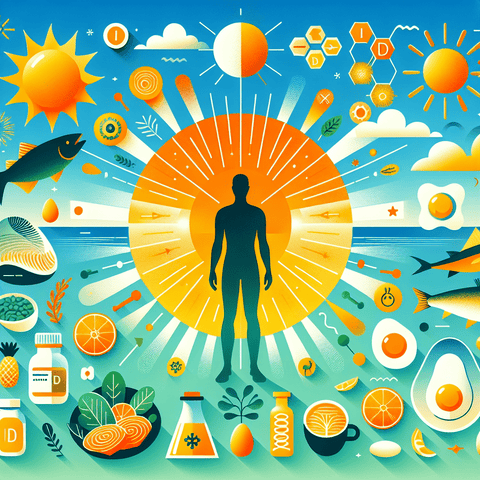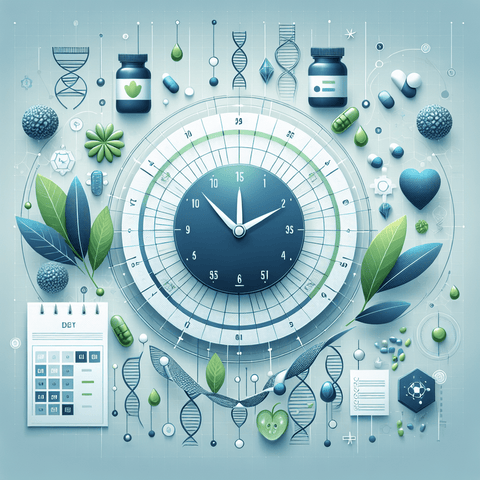Understanding Vitamin D as a Crucial Nutrient for Overall Health
Vitamin D is often referred to as the “sunshine vitamin” due to the body’s ability to synthesize it through skin exposure to sunlight. It plays an indispensable role in various physiological processes, making it essential for sustaining optimal health. But what precisely does it do, and why has it become a centerpiece in discussions about nutritional supplementation? Vitamin D is a fat-soluble vitamin that functions as a prohormone. Once synthesized or ingested, it undergoes activation in the liver and kidneys, converting into its active form, calcitriol. This form plays a key role in calcium homeostasis and bone metabolism. Without enough vitamin D, calcium absorption in the intestines may be impaired, which can lead to brittle bones and conditions like rickets in children or osteomalacia in adults. The nutrient is also closely involved in immune function modulation, influencing T-cell behavior and playing a protective role in some autoimmune responses. Natural sources of vitamin D include fatty fish such as salmon, sardines, and mackerel, as well as egg yolks and fortified foods like dairy products and cereals. However, dietary intake alone often falls short of meeting daily requirements, especially in people with restrictive diets. The most efficient natural source remains ultraviolet B (UVB) radiation from the sun, which facilitates the production of cholecalciferol (vitamin D3) in the skin. Yet, misconceptions abound. Some people believe they get enough vitamin D simply by strolling outdoors, while others think their multi-vitamin suffices—neither of these is universally valid. Moreover, vitamin D is not always grouped with other essential nutrients like vitamin C or magnesium, whose benefits are more immediately noticeable, such as promoting energy or reducing tiredness. Still, vitamin D forms the backbone of long-term skeletal and immune health. There’s an increasing market for supplements thanks to growing awareness. On platforms like Topvitamine.com’s Vitamin D section, consumers can find various formulations, including capsules, oils, and sprays tailored to different preferences and absorption needs. So, is it nonsense to take vitamin D? Far from it. But the efficacy and necessity of supplementation depend on individual circumstances, lifestyle, and current serum levels. The rest of this article will explore how widespread deficiency is, who needs it the most, when supplementation is beneficial or potentially risky, and whether taking vitamin D deserves a place in your wellness strategy.Vitamin D Deficiency: How Common Is It and What Are the Risks?
Vitamin D deficiency has been recognized as a major public health concern. Despite public health efforts, a significant percentage of both adult and pediatric populations fail to maintain adequate vitamin D levels. According to the European Food Safety Authority (EFSA) and other global health organizations, deficiency can pose serious short- and long-term health challenges. Estimates show that nearly 40% of the European population suffers from vitamin D insufficiency, with around 13% considered deficient. These numbers vary based on geographical location, season, and lifestyle habits. Countries situated at higher latitudes that experience less sun during winter—such as the Netherlands, the UK, and parts of Scandinavia—report higher prevalence rates. Urbanization also plays a role, as many jobs and lifestyles limit outdoor exposure. Even in sun-rich countries, people may avoid sunlight due to skin cancer concerns or fashion habits, thus diminishing natural synthesis. The risks associated with vitamin D deficiency are multifaceted. On the skeletal front, insufficient vitamin D can compromise calcium absorption, leading to rickets in children and osteomalacia in adults—both conditions involve softening of the bones. In the elderly, low vitamin D status is linked to increased fall risk and bone fractures, often due to coexisting muscle weakness. But the consequences extend beyond bones. An underactive immune system is a noted risk factor, especially during flu season. Observational studies have found that individuals with lower vitamin D levels are more prone to respiratory infections, though causality is still being explored. Some research even indicates associations between deficiency and higher risks of conditions such as hypertension, type 2 diabetes, and cardiovascular events, though these relationships are not yet clearly defined enough to warrant health claims under EFSA guidelines. Certain groups are particularly vulnerable to deficiency, including older adults due to decreased skin synthesis and renal activation capacity, dark-skinned individuals (melanin reduces the skin's ability to produce vitamin D), people with obesity (vitamin D is sequestered in fat cells), and vegans or vegetarians with limited dietary sources. Health authorities often recommend regular testing of serum 25-hydroxyvitamin D levels in high-risk groups, especially during months with reduced sunlight. When levels fall below the adequacy threshold—as defined by EFSA at a serum level below 50 nmol/L—intervention through supplementation often becomes necessary. To help meet your vitamin D needs, consider quality supplements such as those available from Topvitamine's Vitamin D category. Their product range accommodates different dosages and delivery methods to match individual needs, which can be particularly helpful for those with absorption issues or dietary restrictions.Sunlight and Vitamin D: Can Sun Exposure Suffice or Is Supplementation Necessary?
Sunlight undoubtedly plays a pivotal role in vitamin D synthesis, and under ideal conditions, it is considered the most natural and efficient method of acquiring this nutrient. However, multiple variables determine whether sun exposure alone is enough to meet an individual's needs. The body begins synthesizing vitamin D when ultraviolet B (UVB) photons strike the skin, converting 7-dehydrocholesterol to previtamin D3, and eventually into vitamin D3. However, the efficiency of this process depends on several factors. Latitude is one such determinant. People living above 37 degrees north or below 37 degrees south experience reduced UVB radiation during fall and winter, effectively rendering endogenous synthesis impossible during these months. Skin pigmentation is another crucial factor. Melanin absorbs UVB radiation and thus inhibits vitamin D production. This means individuals with darker skin tones require longer sun exposure to produce the same amount of vitamin D as those with lighter skin. Furthermore, age affects synthesis efficiency; older adults have significantly lower quantities of the precursor compound in their skin compared to younger individuals. The time of day also matters—UVB intensity peaks around midday—yet many people avoid this window due to skin cancer concerns. Sunscreen, while crucial for skin protection, can also block up to 95% of UVB radiation when applied properly. Wearing long sleeves, hats, and staying indoors further minimizes exposure. Considering these nuances, it’s understandable why reliance on sunlight alone may not suffice for many people globally. While daily exposure of arms and legs for 10-30 minutes a few times a week might be enough for some, this is heavily contingent on geographical and personal variables. Public health guidance often encourages safe sun exposure, but also acknowledges the limitations of relying solely on this method. For example, EFSA’s stance on dietary reference values considers scenarios where sunlight exposure is minimal or inconsistent. As such, dietary intake or supplementation becomes a crucial secondary source. Supplements can serve as a practical and efficient backup, especially when lifestyle or environmental conditions reduce effective sun exposure. At Topvitamine.com, you’ll find bioavailable vitamin D preparations—including liquid drops ideal for children and seniors, and high-dose capsules for those with diagnosed deficiencies.Vitamin D Supplements Risks: Are There Downsides to Taking Supplements?
While much of the focus surrounding vitamin D is on its deficiency and widespread need, it's equally important to consider the potential risks and side effects of supplementation, especially when used improperly. Like any nutrient, vitamin D can be harmful in excessive quantities. Vitamin D toxicity, though rare, does occur—most commonly from excessive supplement intake rather than sun exposure or food. This condition, known as hypervitaminosis D, can lead to hypercalcemia (excessive calcium in the blood), which may cause symptoms such as nausea, vomiting, muscle weakness, frequent urination, and even kidney damage due to calcium deposits. The threshold for toxicity is substantially higher than typical daily supplement recommendations. EFSA specifies an Upper Tolerable Intake Level (UL) of 100 µg (4000 IU) per day for adults, including pregnant and breastfeeding women. Long-term intake above this limit, especially without monitoring, can pose risks. Certain individuals may be more susceptible to complications. People with hyperparathyroidism, granulomatous diseases, or certain lymphomas may have altered vitamin D metabolism and should only supplement under strict medical supervision. Over-supplementation can also result from stacking multiple sources unknowingly. Someone taking a multivitamin, fortified food products, and standalone vitamin D supplements simultaneously might easily exceed the recommended daily intake. Therefore, appropriate dosing and regular monitoring are vital parts of a safe supplementation routine. Healthcare providers may advise baseline testing followed by targeted supplementation, often reevaluating levels after 3 months to adjust dosage accordingly. It's also crucial to choose high-quality supplements, as not all are created equal. Reputable sources like Topvitamine.com offer laboratory-tested products that adhere to strict quality standards. These supplements also often include co-factors like vitamin K2, which works synergistically with D3 to help direct calcium to the bones rather than soft tissues—a potentially mitigating factor against vascular calcification. While vitamin D supplementation is undoubtedly beneficial in addressing deficiency, the “more is better” approach does not apply. Mindful usage under guidance will ensure its benefits are reaped without incurring harm.Vitamin D Absorption: How Well Do Our Bodies Utilize Supplemented Vitamin D?
Not all vitamin D that enters the body is utilized equally—absorption and bioavailability hinge on multiple factors. Understanding these mechanisms can help maximize effectiveness and inform better supplement choices. Firstly, vitamin D being fat-soluble means it relies heavily on dietary fats for absorption. Consuming supplements alongside meals that contain healthy fats—like olive oil, nuts, or avocados—can significantly improve uptake. Supplements presented as emulsified drops or micellar sprays may also boast enhanced absorption, especially for individuals with digestive disorders. Secondly, certain nutrients act synergistically to boost effectiveness. Magnesium, for instance, is vital for the enzymatic activation of vitamin D in the liver and kidneys. Magnesium deficiency, which is common in Western diets, can impair this process. You can find various high-quality options in the Magnesium support category of Topvitamine, making it easier to complement your vitamin D regimen. Gut health also plays a crucial role. Conditions like celiac disease, inflammatory bowel disease (IBD), or other forms of malabsorption can hinder vitamin D absorption. In such cases, liposomal or sublingual formulations—which bypass traditional digestive pathways—may be more effective. Formulation preferences matter too. Liquid forms, softgels, or sprays often demonstrate higher efficacy compared to tablets, especially in those with digestive limitations. Brands that combine vitamin D3 (more bioavailable than D2) with other co-factors, such as vitamin K2, are particularly advantageous. Another often overlooked factor is consistency. Vitamin D levels accumulate gradually. Daily supplementation at steady doses is typically more effective and better tolerated than large, infrequent "megadoses." In summary, the body's capacity to absorb and utilize vitamin D varies significantly between individuals, emphasizing the importance of personalized approaches. Through well-designed supplements and combinations available on trusted platforms like Topvitamine.com, individuals can optimize their intake with confidence.Optimal Vitamin D Levels: What Should You Aim For?
Achieving and maintaining optimal vitamin D levels is a topic of ongoing scientific exploration. However, most health authorities, including EFSA and the Institute of Medicine (IOM), have established general guidelines to help determine adequacy. The most accepted biomarker for vitamin D status is serum 25-hydroxyvitamin D concentration. EFSA defines sufficiency as a level equal to or greater than 50 nmol/L. Levels between 30–50 nmol/L are considered insufficient, and anything below 30 nmol/L typically qualifies as deficient. Optimal levels for extra-skeletal benefits—while not officially acknowledged in EFSA claims—are often cited in research as ranging between 75–125 nmol/L. Testing is typically done via a simple blood test and is most valuable when done during the end of winter, the period when levels are expected to be the lowest. Results help guide the appropriate dosage of supplements. Supplying your needs through food can be challenging. On average, dietary sources provide only about 10–20% of daily requirements. Hence, supplementation becomes a preferred method, especially when personalized based on test results. Clinicians may recommend daily intakes of 10–25 µg (400–1000 IU) for most adults and up to 50 µg (2000 IU) in higher-need individuals. It's crucial to note that individual needs vary based on factors including age, body weight, skin type, sun exposure, and existing health conditions. This makes a one-size-fits-all approach ineffective. For those looking to enhance their status safely, monitored supplementation combined with lifestyle and dietary adjustments is best. Quality supplement options from Topvitamine can make formulating a plan straightforward. Regular review and testing remain the cornerstone of effective vitamin D management.Is Taking Vitamin D Nonsense or Necessary? The Bottom Line
So, is it nonsense to take vitamin D? When evaluated through a scientific lens, the answer is a resounding no—provided it’s taken with intent and knowledge. Vitamin D is integral to multiple biological functions, from maintaining bone structure to supporting immune performance. Widespread deficiency due to modern lifestyle patterns makes supplementation not only sensible but often essential, particularly in vulnerable populations. That said, supplementation is not a universal necessity for everyone all the time. Blanket supplementation without testing, knowledge of individual needs, or monitoring can pose risks—be it inefficacy at low dosages or toxicity at high levels. Several myths have clouded public perception. For instance, some argue that supplementation is unnatural, yet supplementation compensates for unnatural modern habits—indoor lifestyles, sunscreen use, and dietary restrictions. Another myth is that taking very high doses boosts immunity, when in reality, a physiological ceiling exists for what serum levels can do. Thus, a personalized approach, guided by testing and healthcare insights, is paramount. Combining sunlight exposure, fortified foods, and high-quality supplements from reputable sources like Topvitamine.com allows individuals to safely and effectively manage their status. In short, taking vitamin D is far from nonsense—it’s a well-supported therapeutic strategy, provided it's approached responsibly.Practical Recommendations for Dietary and Supplemental Vitamin D Intake
Navigating the conflicting information around vitamin D requires a grounded approach. The best strategy combines multiple sources and considers personal lifestyle factors. From a dietary standpoint, prioritize vitamin D-rich foods where possible. This includes oily fish (e.g., salmon, mackerel), fortified dairy or plant milks, mushrooms exposed to UV light, and eggs. However, to reliably meet daily needs, supplementation can fill the gap—especially in populations with restricted diets, such as vegans or people with allergies. Smart sun exposure is also key. Aim for brief time periods (10-30 minutes) of sun exposure to bare skin (face, arms, legs) a few times per week, without sunscreen and outside peak UV hours. However, in northern climates, winter months may offer little UVB exposure, making supplementation necessary. When choosing a supplement, consider your absorption capacity. Those with gastrointestinal issues may benefit from liquid or spray formats. Also consider co-nutrients: combining vitamin D with vitamin K2 can aid calcium regulation; pairing it with magnesium improves bioactivation. Consulting with a healthcare provider for blood tests before starting a regime is strongly advised. This helps avoid both deficiency and toxicity, and allows for customized dosing. For convenient and quality supplementation, Topvitamine offers a comprehensive collection of vitamin D products that cater to different needs—from daily maintenance to high-dose therapeutic uses.Conclusion: Making Informed Decisions About Vitamin D Supplementation
Vitamin D stands as one of the most critical yet easily overlooked nutrients in modern health management. Its profound impact on bone health, immunity, and potential chronic disease prevention makes it anything but trivial. Sunlight and diet provide pathways to sufficient levels, yet changing lifestyles and natural limitations often necessitate supplementation. Still, not everyone requires the same dosage, and blind supplementation carries risks. A data-driven, personalized approach—supported by quality testing, medical advice, and reputable products—is key. With informed choices and responsible use, vitamin D can be a powerful tool in your wellness arsenal. Platforms like Topvitamine.com help streamline your journey by offering trusted and science-based supplement options.Q&A Section
Q: Is it safe to take vitamin D every day?A: Yes, daily supplementation is generally safe within recommended ranges. EFSA advises no more than 100 µg (4000 IU) per day for adults unless otherwise directed by a healthcare provider. Q: Can I get enough vitamin D from food alone?
A: It’s difficult. Dietary sources usually contribute only 10-20% of daily needs. Fortified foods and supplementation often become necessary, especially in sun-deficient seasons. Q: When is the best time to take vitamin D supplements?
A: Vitamin D is fat-soluble, so take it with a meal that includes healthy fats for optimal absorption. Q: Who should get tested for vitamin D deficiency?
A: Older adults, people with dark skin, those who live at high latitudes, individuals with chronic illnesses, and anyone with low sun exposure should consider testing. Q: Are liquid or capsule supplements better?
A: It depends on individual needs. Liquids may absorb more quickly, especially for those with digestive issues, while capsules are convenient and stable.



